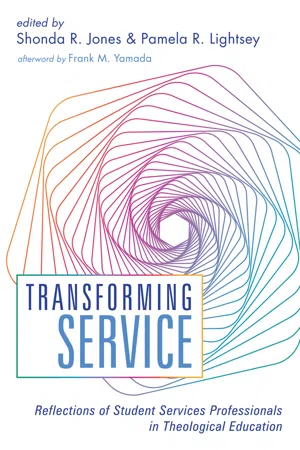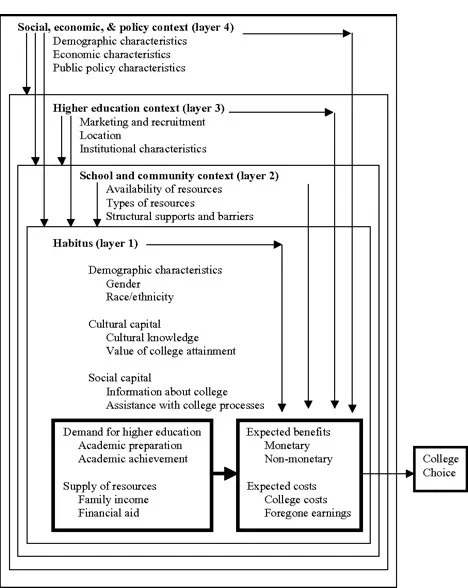![]()
Chapter 1
Graduate Theological School Choice
A Case for Multiplicity
Shonda R. Jones
Amid all the change occurring within graduate theological education, the student profile of those attending theology schools has shifted dramatically with more racial/ethnic minority students seeking graduate ministry degrees. Reflecting on this hallmark shift in what historically has been a space that has been white and male-centered, theological institutions must adapt strategies and service models to attract, retain, and educate students of color. Thus, the work before us is to deeply examine the potential pool of candidates attending seminaries and understand more fully the students of color in our midst. Unfortunately, assumptions are often made about who these students are, their motivations for seeking graduate ministry degrees, and what they need to excel in theological education. Oftentimes there is the inexplicable notion that these are monolithic communities or that there are not important differences that require attention and distinct pedagogical strategies needed inside and outside the classroom. As theological educators and student services professionals, it is essential that we consider the layered realities and multiplicity of students of color in order to cultivate a meaningful and sustained culture in which these students can thrive. It is this backdrop that motivated me to make this the focus of my research and subsequent dissertation work.
This chapter, using data that emerged from my doctoral research, examines particularly how the school choice process unfolds for US racial/ethnic students enrolled in the Master of Divinity (MDiv) degree program at Wake Forest University School of Divinity. That is to say, I will focus attention on how students in a particular divinity school describe their decision-making as they considered graduate theological education. This discovery takes place as a result of twenty-seven students of color being interviewed and sharing individual stories of their lives, family context, educational background, aspirations, and vocational goals. Further, each student of color talked specifically about their graduate theology school choice process. These students are African-American, Biracial, Latinx, and Multiracial students enrolled in the MDiv degree program in an ecumenical university-related divinity school. Those interviewed represent a diverse group of students with different backgrounds. While the mode age is twenty-three years old, ages of the student participants ranged from twenty-three years old to sixty years old, with an average age of thirty years old. Though there are commonalities in some cases, no single story is exactly the same. As each individual is unique, so is their narrative. Racial/ethnic minority students are not uniform and offer distinctive and personal accounts of their aims, opinions, beliefs, motivations, and values. The narratives of these students represent the weaving together of stories that highlight the individuality of persons (habitus—their system of values and beliefs that shape their views and interpretations), while also holding in tension the structural contexts that make up the material and economic realities of not only persons, but communities of peoples. Thus, the process of how racial/ethnic students choose the MDiv program has not been completely clear. This is what I would hope to uncover by centering the narratives of students of color.
Let me briefly summarize the relevance of examining students of color and why their choice process is crucial to theological schools. Graduate theological education in America and Canada has recently demonstrated enrollment stability after years of a dramatic decrease in student enrollment in theological schools accredited by the Association of Theological Schools (ATS). However, pressure remains in what has traditionally been considered the gold standard degree—the Master of Divinity. The number of students enrolled in the MDiv went from about 29,300 in 1998 to 28,400 in fall 2017. It is important to note that the MDiv reached its peak enrollment at nearly 35,000 student headcount in 2006. Recently, the overall numbers are encouraging with 50 percent of all ATS schools having enrollment increases in overall enrollment, and 45 percent of all ATS schools had enrollment increases in the MDiv. Much of the gains are evident for evangelical Protestant theological schools, with at least half of the schools having experienced enrollment increases in every degree category from 2016 to 2018. The reality is a bit different for mainline Protestant theological schools where only 40 percent of the schools experienced enrollment increases in the MDiv. However, 60 percent of all ATS schools showed enrollment increases in the professional MA category. While there is obvious growth in professional MA degree enrollment, there also appears to be growth potential in the MDiv with racial/ethnic students. Racial/ethnic minority students enrolled in graduate theological education grew from 13 percent in 1990 to 41 percent in 2017, according to ATS data. Looking at these numbers, I would argue that after a decade of decline, enrollment stabilization has occurred, in part, due to the influx of students of color to graduate theological education. The shifts in the religious environment and those attracted to theology schools will have lasting consequences on theological institutions of the future. The changing trends in graduate theological education have implications for student recruitment, enrollment, and retention, as well as how the school choice process unfolds for particular students considering vocations where theological education is important.
Drawing on data collected through interviews with students of color enrolled in a MDiv program, I examine how their habitus and other social and cultural capital shapes the process of choosing divinity school. I do so by employing Perna’s conceptual model of student college choice as a theoretical frame with a focus on (1) the individual’s habitus; (2) school and community context; (3) the higher education context; and (4) the broader social, economic, and policy context (see figure 1). Drawing on a conceptual model that integrates both economic and sociological perspectives, I assumed that students’ graduate school decisions are determined, at least in part, by their habitus. Thus, this chapter focuses on the students’ habitus, or the system of values and beliefs that shape their views and interpretations. Similarly, I listened for the structural and cultural factors, or organizational habitus, experienced within the undergraduate and other institutional contexts from which racial/ethnic MDiv students emerge. Measures of social and cultural capital that include race, financial resources, and academic preparation and achievement, play an important role in explaining the educational decisions of racial/ethnic students. By exploring these influences, I hope to offer insights into the graduate theology school choice of racial/ethnic MDiv students.
Figure 1. Perna’s Conceptual Model of Student College Choice.
Though Perna’s model specifically examines choice as students move from high school to college, her model can serve as a useful framing of choice as students move from undergraduate studies to post-baccalaureate education—specifically, graduate theological education. While all layers of this model aids in a deeper and nuanced understanding of the school choice process, I am most interested in magnifying the first layer of Perna’s model. Habitus can be linked to one’s embedded social and cultural capital and represents a series of internalized dispositions that individuals use to form perceptions, decisions, and choices. My interest is not so much in why racial/ethnic students choose a particular theology school, but in how these students engaged the school choice process. How is it that these racial/ethnic students decided to enroll in the MDiv program? What does the choice process for this group look like? What internalized messages were front of mind for these students as they decided to pursue their theological degree? Discoveries from these questions can inform student affairs practice and institutional praxis in theological schools, seminaries, and divinity schools.
Understanding School Choice
A number of studies examine undergraduate college choice. Among the most commonly cited model related to college choice is Hossler and Gallagher’s three-stage model of predisposition, search, and choice. The initial stage outlined in Hossler and Gallager’s model is predisposition, which typically occurs between seventh and tenth grades in high school. In this stage, students develop aspirations and interest toward attending college. The second or search stage is when students begin their college search by gathering information about colleges. According to Hossler and Gallagher, it is at this stage that students determine an initial group of colleges and universities that they will consider applying to and proceed to gather information about the institutions. Students also develop preferences among institutions and consider an ability to pay, along with considering criteria for admissions. Likewise, students develop expectations and perceptions about the institution. Search, at the undergraduate level, typically is during the tenth and twelfth grade, while the third stage, also known as choice, occurs in the eleventh and twelfth grades when students select an institution and decide to enroll to a particular college or university. According to Perna, little is known about the timing of the three-stage model for nontraditional enrollment for those who do not attend college immediately after high school. Further, there is limited information about graduate school choice processes. Graduate-level decision process has been ...

